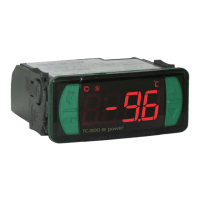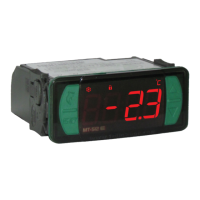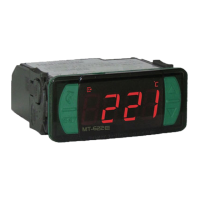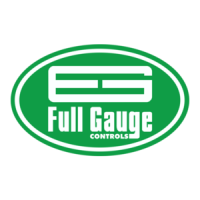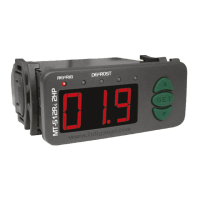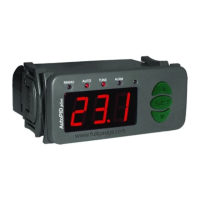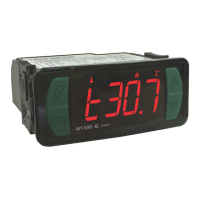[F82] - Variable compressor on time after reaching the sepoint:
After reaching the temperature setpoint, it is possible to keep the compressor running at a speed
calculated by the PID control algorithm. The purpose is to avoid successive starts of the compressor,
obtaining a reduction in energy consumption (energy efficiency) as well as low oscillation of the room
temperature (sensor S1). If set to [Off,], the variable compressor is switched off immediately after
reaching the temperature setpoint. If set to [On,,], the compressor is switched off and will start again
according to the setpoint and the control hysteresis.
[F83] - Variable compressor time below F85 limit frequency for lubrication:
Time in which the variable compressor must be on with the frequency below the limit set in [F85] to
operate at the frequency set in [F76] for the time set in [F84].
This process of periodic acceleration of the control frequency promotes lubrication of the variable
compressor through the migration of the lubricating oil.
[F84] - Variable compressor time on frequency F76 for compressor lubrication:
Time that the variable compressor will stay on at the frequency defined in [F76] for lubricating the
compressor.
[F85] - Minimum frequency for variable compressor lubrication control:
Limit frequency for the instrument to use the variable compressor lubrication process.
[F86] - Maximum time of variable compressor on at maximum frequency:
Maximum time for the variable compressor at maximum frequency. This parameter works together with
[F76].
[F87] - Low temperature limit (differential for the temperature setpoint):
Sets the low temperature limit to be used to turn off the variable compressor. In this parameter, the
differential for the setpoint is adjusted.
Example: Setpoint = [,-6.0]and [F87] = [,,3.0]. In this case, the temperature limit for turning off
the compressor will be [,-9.0] ([,-6.0]–[,,3.0]).
[F88] - High temperature limit (differential for the temperature setpoint):
Sets the high temperature limit to activate the variable compressor at its maximum operating
frequency. The purpose of this parameter is to quickly lower the temperature of the controller
environment. In this parameter, the differential for the setpoint is adjusted. The hysteresis of this
parameter is fixed at 1.0°C (1.8°F).
Example: Setpoint = [,-6.0] and [F88] = [,11.0]
In this case, the compressor will operate at maximum speed [F76] when the temperature is above
[,,5.0] ([,-6.0] + [,11.0]), and will return to normal speed operation (between [F74] and
[F75] when the temperature is below [,,4.0] ([,-6.0] + [,11.0]– [,,1.0]).
[F89]- AUX output mode:
[,,,0] – Output off;
[,,,1] – Lamp: Controls lighting;
[,,,2] – Alarm;
[,,,3] – Door resistance (without S3 sensor): The door heater remais on, regardless of the door
temperature. The resistor is turned off only during the occurrence of alarms;
[,,,4] – Door resistance (with S3 sensor): The door resistance to prevent condensation is
controlled by the temperature of sensor S3 and the values set in functions [F104] and [F105]. The
output is turned off when alarms occur;
[,,,5] – Schedule: The output is switched on/off on the days and times defined in parameters
[F90] until [F95];
[,,,6] – Cycle reversing valve: The output is turned on to reverse the cooling to heating cycle when
the instrument is operating in automatic mode;
[,,,7] – Auxiliary compressor: The AUX output will be used to drive a second compressor. The AUX
output will be activated after the COMP output is activated and the 15 second interval (fixed) has
elapsed. The AUX output will always be turned off together with the COMP output.
Note1 (priority 1): If the instrument is configured for automatic mode ([F00]=2), the AUX output is
automatically configured for cycle reversing valve. If parameter [F00] is modified, it will be necessary
to reset [F89].
Note2 (priority 2): If tray defrost is set to AUX output ([F43]=2), the features of [F89] are ignored.
[F90] - Time to turn on the AUX output if [F89] = 5 (Monday to Friday):
[F91] - Time to turn off the AUX output if[F89] = 5 (Monday to Friday):
[F92] - Time to turn on the AUX output if [F89] = 5 (Saturday):
[F93] - Time to turn off the AUX output if [F89] = 5 (Saturday):
[F94] - Time to turn on the AUX output if[F89] = 5 (Sunday):
[F95] - Time to turn off the AUX output if[F89] = 5 (Sunday):
Times to turn the AUX output on/off on weekdays and weekends. To disable this functionality on a
specific day, just set the time to turn off with the maximum value [Off,].
[F96] - Operating mode for ambient temperature alarms (S1) (0-relative/1-absolute):
Determines whether the values configured for low ambient temperature [,F97] and high ambient
temperature [,F98] alarm will be relative to the setpoint or absolute values.
[,,,0] - The ambient temperature alarms [F97] and [F98] represent values relative to the
setpoint.
Example:Desired temperature [SP,,]: - 5.0°C
Low temperature alarm [,F97]: 2.0°C
High temperature alarm [,F98]: 2.0°C
Limits: ([SP,,]- [,F97] and [SP,,]+ [,F98]).
The low temperature alarm will be signaled at -7.0°C (-5.0°C - 2.0°C) and the high temperature alarm
at -3.0°C (-5.0°C + 2 .0°C).
[,,,1]- Ambient temperature alarms [F97] and [F98] are absolute values.
Example: Low temperature alarm [,F97]:-30.0°C
High temperature alarm [,F98]:15.0°C
The low temperature alarm will be signaled at -30.0°C and the high temperature alarm at 15.0°C.
[F97]- Low ambient temperature alarm (S1):
[F98]- High ambient temperature alarm (S1):
Lower/Upper Ambient Temperature Limits (S1) for the instrument to indicate low/high temperature
alarm. The temperatures configured in these parameters can have their absolute or relative values to
the setpoint depending on the value configured in [,F96]. The differential for alarm shutdown is fixed
at 0.1°C/0.1°F.
[F99] - Length of time door is open to trigger alarm:
When the door is opened, the message [OPen] appears on the display and the door open timer
starts. If this time is longer than the time configured in this function, the audible alarm (buzzer) will be
triggered and the message [AOpn] will be displayed.
Note 1: When the digital input is configured as a pressure switch contact, it allows turning off the
compressor, fan and defrost outputs, displayng the alarm associated with the source input. When the
pressure switch event clears, the controller returns to the configured initial process.
Note 2: When the digital input is configured as combinet defrost, defrost is started (if allowed) when the
contact is closed and advances to the next step only when the contact is opened again.
Note 3: In options 5 and 6, the Sitrad supervisory system has priority over the digital input. This, if Sitrad
sends a command to turn the control functions on/off, the digital input is temporarily disabled and a
transition in its state will be necessary to enable it again.
[F62] - Door open time for instant defrost:
If the door is kept open for a period longer than that defined in this function, instant defrosting will take
place, as long as the temperature in the evaporator (S2/S3 sensor) is less than [F39] and the room
temperature (S1 sensor) is less than [F40].
[F63] - Door open time to turn off compressor and fan:
For safety, if the door open time is longer than the time configured in this function, both the compressor
(COMP or COMP VCC) and the fan (FAN or FAN VSF) will be turned off.
[F64] - Door closed time to turn off the lamp:
With the door closed, this parameter defines how long it will be until the lamp is turned off. Helps save
electricity.
[F65] - Door closed time to activate economy mode:
With the door closed, this parameter defines how long until economy mode is activated. The output for
the lamp will be deactivated if it is turned on and the operational setpoint is switched to the economy
setpoint.
[F66] - Compressor type:
[,,,1] – On-Off type fized speed compressor (relay output).
[,,,2]– Variable Capacity Compressor - VCC with frequency output 0 to 300Hz.
[,,,3] – Variable Capacity Compressor - VCC with voltage output from 0 to 10Vdc.
Note1: The operation of the variable speed compressor (options 2 and 3) is conditioned only to the
cooling operation mode ([F00]=0).
Note2: If [F66] = 1, parameters [F71] to [F88] are ignored and traditional control is performed
via the compressor relay.
Note3: If [F66] = 3, the compressor frequency adjustment parameters are configured as a
percentage (0 to 100%) that correspond directly to the 0 to 10Vdc signal applied to the COMP output
VCC. Values greater than 100% will be considered as 100%.
[F67] - Minimum time for compressor to be on:
This is the minimum amount of time the compressor will be on, i.e. The period of time between the last
section and the next time it is stopped. This helps to avoid power surges from the eletricity grid.
[F68] - Minimum time for compressor to be off:
This is the minimum amount of time the compressor will be off, i.e. The period of time between the last
time it stops and the next section. This helps to relieve the discharge pressure and increases the
working life of the compressor.
[F69]- Compressor on time in case of error in sensor S1 (room temperature):
[F70]- Compressor off time in case of error in sensor S1 (room temperature):
If the room sensor (S1 sensor) is disconnected or goes out of the measurement range, the compressor
will switch on or off according to the parameters set in theses functions.
[F71] - Proportional Gain (P):
Determines the proportional increase based on the PID Control Algorithm.
[F72]- Integral Time (I):
Determines the Integral Time based on the PID Control Algorithm.
[F73]- Derivative Time (D):
Determines the derivative time of the PID Control Algorithm.
[F74] - Minimum frequency for variable compressor PID control:
Defines the minimum working frequency of the variable compressor in automatic control mode (PID
algorithm).
Note: check the technical manual of the variable compressor.
Note: If [F66]= 2, the value configured in this parameter is ignored and considered as 0%.
[F75]- Maximum frequency for variable compressor PID control:
Defines the maximum working frequency of the variable compressor in automatic control mode (PID
algorithm).
Note: check the technical manual of the variable compressor.
[F76] - Maximum operating frequency of the variable compressor:
Defines the maximum operating frequency of the compressor. This frequency is used when it is
necessary to quickly cool the controlled environment, e.g., high room temperature, Fast Freezing
process or after a defrost cycle.
Note: check the technical manual of the variable compressor.
[F77] - Compressor stop frequency (switch-off):
Defines the output frequency to inform the compressor to stop. This frequency is lower than the
minimum working frequency.
Note: check the technical manual of the variable compressor.
Note: If [F66] = 2, the value configured in this parameter is ignored and considered as 0%.
[F78] - Variable compressor frequency during hot gas defrost:
Dsets the variable compressor frequency during the hot gas defrost process.
[F79] - Variable compressor frequency in case of error in sensor S1 (room temperature):
Defines the frequency of the variable compressor if an error is detected for temperature sensor S1
(room sensor). This parameter works together with [F69] and [F70].
[F80] - Variable compressor soft start frequency:
When switching on the variable compressor, it is kept at a low speed for a few seconds, as set in [F81].
The purpose of this feature is to improve the lubrication of the compressor.
[F81] - Variable compressor soft start time:
Time the variable compressor will be on at the soft start frequency. The purpose of this feature is to
improve the lubrication of the compressor.
